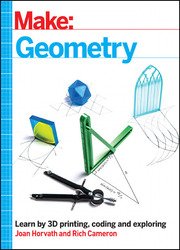 Название
Название: Make: Geometry: Learn by coding, 3D printing and building
Автор: Joan Horvath, Rich Cameron
Издательство: Make Community, LLC
Год: 2021
Страниц: 312
Язык: английский
Формат: epub
Размер: 43.8 MB
Geometry, of all the branches of mathematics, is the one that is most easily visualized by making something. However, it is all too easy to reduce it to reams of formulas to memorize and proofs to replicate. This book aims to take geometry back to its practical roots with 3D printed models and puzzles as well as demonstrations with household objects like flashlights and paper towel tubes.
This is not a traditional geometry textbook, but rather builds up understanding of geometry concepts encountered primarily in middle school while also bringing in elements of concepts normally learned much later. Some of the models are counter intuitive, and figuring out how and why they work will both entertain and give insights. Two final chapters suggesting open-ended projects in astronomy and physics, and art and architecture, allow for deeper understanding and integration of the learning in the rest of the book.
The models were written in the free, open-source CAD program OpenSCAD. If you don’t have a 3D printer readily available, visualizing and manipulating the models in the OpenSCAD environment will provide some of the experience. OpenSCAD runs on laptop or desktop computers running Windows, macOS, or Linux. Creating models in OpenSCAD requires learning computer programming skills, but we give enough pointers that someone without that background should be able to manage the basics. We encourage you, though, to print the models on any consumer-level filament-using 3D printer. As we discuss in Chapter 2, decent printers can be found in the under $500 range, and many community libraries have printers available.
This book aims to take geometry back to its physical roots with 3D printed models, as well as demonstrations with household objects. Often, we’ll mention the circumstances under which the math was invented. We find doing that helps us think about how to frame it for someone else who is seeing a concept for the first time. Chapters 2 and 3 dive into OpenSCAD, a code-based computer-aided design (CAD) program. The models in the rest of the book are written in OpenSCAD. Since OpenSCAD requires that models be built in a programming language that is somewhat like C or C++, this book could also motivate a learn-to-code curriculum.
Скачать Make – Geometry: Learn by Coding, 3D Printing and Building
[related-news]
[/related-news]